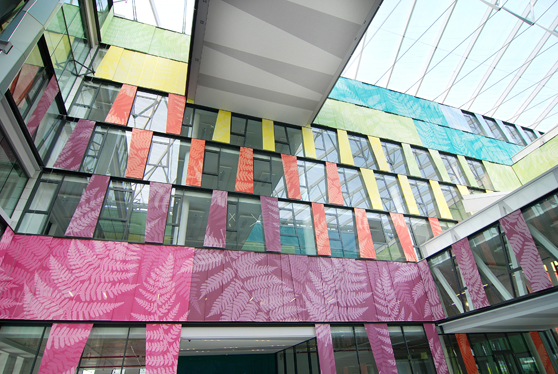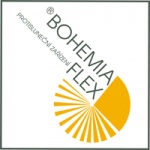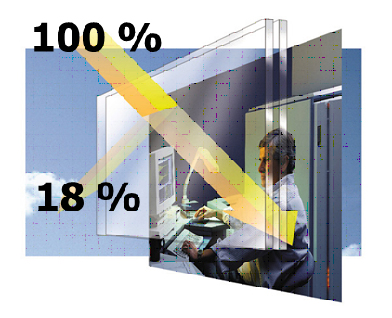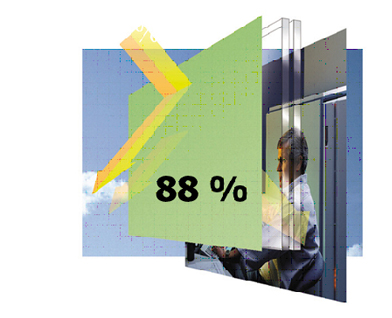
Textile shading – a solution for comfort and aesthetics of buildings
Glass is the "chosen" building material in residential and office buildings as well as in commercial spaces. Its undeniable benefit is the influx of natural light and a certain level of comfort for users when interacting with the outside world. However, large glazed surfaces can also become an easy source of overheating and relentless glare in interiors.
An essential solution for maintaining user comfort in buildings is the addition of effective solar protection that prevents sunlight from impacting glass surfaces, heating them, and allowing heat to penetrate into rooms.
For a long time, aluminum sunshades were favored. They were popular at a time when industry had not yet advanced far enough to offer very functional textile protection against the negative effects of sunlight. Today's technical fabrics have far better functionality in protecting buildings from temperature fluctuations while maintaining an excellent balance of natural light penetration and views from buildings. No all-aluminum exterior protection can complement architects’ and developers' intentions in constructing glazed buildings that do not enclose their users in dark office and meeting room bunkers.
Technical fabrics not only allow regulated penetration of natural light and views outside, but also, thanks to their technical properties, can block – depending on the fabric type – up to 96% of harmful solar radiation. This protection is also passive, minimizing the use of artificial light and/or air conditioning, which are jointly responsible for more than 40% of carbon dioxide emissions. In today's world, where energy savings are topic number one and energy efficiency of buildings is becoming part of legislation, a rational approach to solar protection is more than desirable. Shading techniques are no longer just an aesthetic addition, but an integral part of architectural and development studies.
Widely used passive solar protection in the form of external textile roller shades allows us to achieve significant savings in energy consumption. In summer, temperatures in rooms of buildings with more than 50% glazed facades can rise by up to 15°C above outdoor temperatures. By simply installing external textile roller shades, we can reduce this temperature by 15°C and thereby limit the need for air conditioning.
Conversely, in winter, the same shades prevent heat loss, thereby reducing energy consumption needed for heating buildings.
Technical fabrics also feature other properties that are appreciated by users of modern buildings:
Amazon Court – an example of successful application of technical fabrics in public space
The multifunctional complex Amazon Court won a special prize at the International Summit of Property Professionals in 2008 in the shopping center category. The third building of the River City Prague development project, located in Prague's Karlín district, was designed by the Danish firm Schmidt Hammer Lassen Architects and completed in early 2009. This jewel among office buildings with an area of 19,800 m² is situated in the developing Prague district of Karlín. Residents of the building have access to a green space in the atrium, which contributes to the thermal and acoustic comfort of the building and reflects the principle of sustainable development.


Aesthetic demands
Decorative panels made from 12,000 m² of fabric and placed around the perimeter of the 2,000 m² atrium in 4-panel modules in the shape of rectangles and trapezoids provide the facade with a harmonized revitalization and an unforgettable aesthetic impression both day and night. For their aesthetic perfection, a white color was chosen as the background for digital printing in 8 different colors: a shaded color palette from sky blue to pink through turquoise, green, yellow, orange, and purple, all in motifs of the Amazon jungle.
Technical quality
The implemented technical solution aimed to meet users' requirements for protection against solar radiation and to ensure thermal comfort while minimizing energy consumption. The solution we brought to Amazon Court meets all these requirements. The Japanese wall system is made from the highest quality materials with a touch of Italian design. The desired properties to protect users from the sun were particularly achieved by the choice of fabric. Mermet fabrics hold the quality certificates Oeko-Tex Standard 100, Greenguard, and Enduris Glass Core, thus providing excellent attributes in terms of health and safety in public buildings. The Panama weave of the supplied fabric ensures excellent transparency and allows natural light to penetrate indoors even through the printing. The selected fabric combined with the system provides effective protection against glare and captures up to 90% of UV radiation. The surface of the fabric is ideal for use in decorative panels due to its exceptional shape softness and stability, outstanding mechanical resistance, and very good tear resistance. All Mermet fabrics are also an excellent medium for printing, providing perfect depiction and excellent detail rendering regardless of the chosen printing method. Images and colors can thus be applied to the fabric flawlessly, offering perfect representation of the smallest details of the jungle motif in the case of Amazon Court.
In conclusion
The Amazon Court building demonstrates that administrative buildings can meet functional and aesthetic demands while simultaneously saving energy for heating and cooling. Such technical solutions provide solar protection that ensures comfort for the building's occupants as well as meeting the operator's demands for energy efficiency and environmental considerations. It also confirms the necessity of expertise from shading technology suppliers and their close cooperation with architects and designers already in the design phase.



Ivana Střílková, MBA
Co-owner of Bohemiaflex CS, s.r.o.
Bohemiaflex CS – comprehensive solar protection solutions
An essential solution for maintaining user comfort in buildings is the addition of effective solar protection that prevents sunlight from impacting glass surfaces, heating them, and allowing heat to penetrate into rooms.
For a long time, aluminum sunshades were favored. They were popular at a time when industry had not yet advanced far enough to offer very functional textile protection against the negative effects of sunlight. Today's technical fabrics have far better functionality in protecting buildings from temperature fluctuations while maintaining an excellent balance of natural light penetration and views from buildings. No all-aluminum exterior protection can complement architects’ and developers' intentions in constructing glazed buildings that do not enclose their users in dark office and meeting room bunkers.
|
|
|
Widely used passive solar protection in the form of external textile roller shades allows us to achieve significant savings in energy consumption. In summer, temperatures in rooms of buildings with more than 50% glazed facades can rise by up to 15°C above outdoor temperatures. By simply installing external textile roller shades, we can reduce this temperature by 15°C and thereby limit the need for air conditioning.
Conversely, in winter, the same shades prevent heat loss, thereby reducing energy consumption needed for heating buildings.
Technical fabrics also feature other properties that are appreciated by users of modern buildings:
- protection against direct glare, which is appreciated by anyone working with computers and other types of screens
- true transparency – while aluminum external blinds completely darken a room, with textile roller shades you still retain a sense of openness and space
- resistance to temperature fluctuations
- protection against UV radiation that causes fading of fabrics indoors, furniture, paintings, and wall colors
- the properties of technical fabrics in the field of solar protection meet the requirements of standard EN 14501 and its Czech equivalent ČSN EN 14501 Blinds and Shutters – Thermal and Visual Comfort – reducing air conditioning consumption by up to 30%
- creating a favorable climate in rooms
- protection against insects
- high aesthetic quality – today technical fabrics are produced in modern designs that rival classic woven fabrics
Amazon Court – an example of successful application of technical fabrics in public space
The multifunctional complex Amazon Court won a special prize at the International Summit of Property Professionals in 2008 in the shopping center category. The third building of the River City Prague development project, located in Prague's Karlín district, was designed by the Danish firm Schmidt Hammer Lassen Architects and completed in early 2009. This jewel among office buildings with an area of 19,800 m² is situated in the developing Prague district of Karlín. Residents of the building have access to a green space in the atrium, which contributes to the thermal and acoustic comfort of the building and reflects the principle of sustainable development.
 |


Aesthetic demands
Decorative panels made from 12,000 m² of fabric and placed around the perimeter of the 2,000 m² atrium in 4-panel modules in the shape of rectangles and trapezoids provide the facade with a harmonized revitalization and an unforgettable aesthetic impression both day and night. For their aesthetic perfection, a white color was chosen as the background for digital printing in 8 different colors: a shaded color palette from sky blue to pink through turquoise, green, yellow, orange, and purple, all in motifs of the Amazon jungle.
 |
The implemented technical solution aimed to meet users' requirements for protection against solar radiation and to ensure thermal comfort while minimizing energy consumption. The solution we brought to Amazon Court meets all these requirements. The Japanese wall system is made from the highest quality materials with a touch of Italian design. The desired properties to protect users from the sun were particularly achieved by the choice of fabric. Mermet fabrics hold the quality certificates Oeko-Tex Standard 100, Greenguard, and Enduris Glass Core, thus providing excellent attributes in terms of health and safety in public buildings. The Panama weave of the supplied fabric ensures excellent transparency and allows natural light to penetrate indoors even through the printing. The selected fabric combined with the system provides effective protection against glare and captures up to 90% of UV radiation. The surface of the fabric is ideal for use in decorative panels due to its exceptional shape softness and stability, outstanding mechanical resistance, and very good tear resistance. All Mermet fabrics are also an excellent medium for printing, providing perfect depiction and excellent detail rendering regardless of the chosen printing method. Images and colors can thus be applied to the fabric flawlessly, offering perfect representation of the smallest details of the jungle motif in the case of Amazon Court.
In conclusion
The Amazon Court building demonstrates that administrative buildings can meet functional and aesthetic demands while simultaneously saving energy for heating and cooling. Such technical solutions provide solar protection that ensures comfort for the building's occupants as well as meeting the operator's demands for energy efficiency and environmental considerations. It also confirms the necessity of expertise from shading technology suppliers and their close cooperation with architects and designers already in the design phase.



Ivana Střílková, MBA
Co-owner of Bohemiaflex CS, s.r.o.
Bohemiaflex CS – comprehensive solar protection solutions
The English translation is powered by AI tool. Switch to Czech to view the original text source.
0 comments
add comment














